Common Diseases & Conditions in Pets S-Z
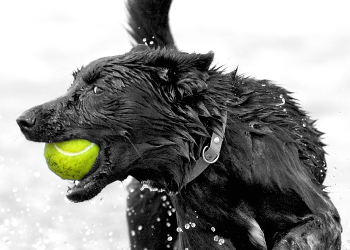
Seborrhea sicca is a member of the Seborrhea Complex. It is differentiated from Seborrhea oleosa by the lack of excessive sebum production on the skin. Dry, flaky skin is the hallmark of this medical condition. Seborrhea sicca is commonly caused by:
1. Endocrine Diseases: Hypothyroidism and Cushing’s Syndrome are common causes.
2. Bacterial: Bacterial pyodermas can lead to this condition.
3. Parasitic Mites: Demodectic and Sarcoptic mange can cause this problem.
4. Cancer: Many cutaneous neoplasias such as cutaneous lymphosarcoma can produce a secondary seborrhea oleosa.
5. Fungal/Yeast Infections: The big guy on the block here is Malassezia yeast. They frequently cause seborhhea sicca.
Seborrhea sicca is often seen together with Seborrhea oleosa, an oily type of seborrhea.
In Seborrhea sicca, excessive sebum is also produced since both types of seborrhea can be seen at the same time. This excessive sebum accumulates and clogs hair follicles. The dog or cat has a literal coat of sebum over its body. Sebum production is greatest along the flanks, ears and lumbar back area. This buildup causes the animal to scratch at itself. This produces dander, inflamed papules and other lesions. This irritation often sets up a bacterial pyoderma or yeast infection. In the case of seborrhea sicca, dry flaky skin is usually more extreme than sebum production.
Pets will often have a foul odor about them. There may be excess sebum present since seborrhea oleosa and sicca will be often present in the same animal. Yeast infections can cause a sweet, foul odor to the skin. Bacteria can metabolize oils and produce oil metabolites. One of the chief complaints people made to me was that “horrible stinky odor that my dog has plus all the furniture stinks”. I understood clients on that one. I often could diagnose the condition before I even walked into the exam room!
Many times there will be skin folds present; which are full of sebum with bacteria and or yeast. This is a huge problem in English Bulldogs and others with natural folds of skin over the body. There will also be present: raised papules, dander and general skin inflammation.
A CBC and Chemistry profile are always performed. Both of these tests will often lead the doctor to order further tests based on those results. Skin scrapings are always done to eliminate mites. Fungal cultures are done to rule out a dermatomycosis (including ringworm). ACTH Stimulation Tests are done if suspecting Cushing’s Syndrome. T4 and FT4 are performed if suspecting hypothyroidism. Surgical biopsies may be done.
Diagnosis is made by a history obtained from the owner plus the presentation of clinical signs. The primary cause is figured out by concurrent lab work test results. A surgical biopsy may lead to a diagnosis or confirm one that was tentative.
Treatment is initially geared to treating the primary cause of the Seborrhea lesions. Yeast infections are treated with Ketoconazole. Bacterial pyodermas are treated with antibiotics such as Clavamox® or Baytril® for long periods of time. Endocrine disorders such as Cushing’s Syndrome are treated with Lysodren® or Trilostane®. Hypothroidism is treated by oral T4 administration.
Pruritus is usually controlled by Atarax® (hydroxyzine). This is a prescription antihistamine that alleviates some of the clinical signs associated with itch. One has to be careful about using corticosteroids. They will provide relief but can suppress the animal’s immune system making it much harder to treat a bacterial, fungal or yeast infection. Giving corticosteroids to a suspect Cushing’s Syndrome patient can make the condition worse! If the patient is a diabetic, steroids will really throw off the blood glucose and play havoc with an insulin dose.
Topical shampoos are crucial in providing some relief from clinical signs plus return the skin to a more normal condition. Shampoos containing chlorhexidine and or combinations of chlorhexidine and ketoconazole are very effective, if used properly. Some of the best products for this purpose are made by Virbac®. The best shampoo interval is twice the first two weeks, than once weekly for months on end. Do not use warm water. Use cool tap water or water from an outdoor hose. Warm water will make the animal scratch even more! Repeating the shampooing will keep sebum production under control; as long as the primary disease condition is being treated.
If a cause of seborrhea can not be determined, the condition is treated with antibiotics, ketoconazole and shampoos. Oral cyclosporine (Atopica®) may help some of those patients.
The prognosis for seborrhea sicca depends upon the primary cause of the medical condition. The prognosis for idiopathic seborrhea sicca is more guarded since a cause can not be found. Supportive medical care will at least keep those conditions under control in most situations.



Seizures can be caused by many things. Low calcium and blood sugar, poisons, antifreeze, bacterial (tetanus caused by Clostridium tetani), tumors and heat stroke are just a few of the medical conditions that can cause animals to seizure. One of the most common causes of cat seizures is FIP; a severe corona virus of cats. Status Epilepticus or Epilepsy is one of the most common causes of seizures in dogs. The cause of epilepsy is unknown and hence known as idiopathic epilepsy.
There may be a genetic cause to epilepsy but that has not been proven. Brain activity is altered. An analogy would be like lights flickering on and off. Just like a short circuit about ready to happen in a homes electrical system, the same thing happens in an animals brain. Prior to a seizure, animals may appear clinically normal. Certain stimuli can set off a seizure. Going outdoors to urinate. Going on a walk. Going up and down stairs. Dogs may become hyperesthetic (extremely and exceedingly sensitive) to any noise. Clapping of the hands, dogs barking, trucks backfiring can all cause an animal to seizure in certain conditions.
Clinical signs of epilepsy in dogs and cats can be insidious. No one knows why they start at a certain age. Some patients are young while others are senior citizens! The most important thing to mention is that all seizures (unless they are grand mal) do not cause any pain or discomfort to the animal. It causes more pain and consternation in their owners; which is totally natural! Animals can hurt themselves if they seizure going up or down stairs or fall off of an object.
Some animals may have a fascicular tic; a slight twitch that disappears and goes away. The most common seizure occurs suddenly with the pet becoming recumbent. They have no idea where they are. They often salivate, vomit, or defecate. Their front limbs are in a “bicycling position”; just like they are riding a bike! Their eyes look straight ahead. The majority of these seizures last anywhere from about 1-5 minutes in duration. The animal gets up exhausted but than acts normal.
The worst type of seizure is the grand mal seizure. These are seizures that do not stop! This is a true medical emergency! The same clinical signs as above but more severe. The entire musculature of the body is in one huge muscle spasm. These muscle spasms generate a tremendous amount of heat. Left untreated, they will go into heat stroke and develop renal failure, brain swelling and DIC (Disseminated Intravascular Coagulopathy).
Dogs and cats should seek immediate medical care if a seizure has occured; even if they appear normal. A CBC and Chemistry profile will be formed to check if there is any physical reason for the pet to seizure. Profiles can rule out low glucose or calcium problems as well as liver issues. A EKG can rule out heart problems along with radiographs or cardiac ultrasounds. A CT scan may be performed at a veterinary medical teaching institution.
History is perhaps the most important part of initially trying to formulate a diagnosis. The veterinarian will ask if there has been any exposure to any type of poison. Was the animal hit by a car recently? Is the pet on medications like insulin? Did the patient (if female and small) give birth to a large litter? This suggests eclampsia; a condition due to low serum calcium levels. A tentative diagnosis of idiopathic epilepsy can be given if no historical findings are found and no physical lab abnormalities are discovered. The latter is what usually happens.
If a patient has a short bout with epilepsy I usually gave the animal a complete physical and performed blood work. If the history was negative for toxins and the like, I usually did not treat the condition if it was the FIRST seizure of short duration. I did tell the owners that a seizure could happen at any time; even after just leaving the medical office! Owners should keep a diary of any seizure activity. The time of day, possible trigger for the seizure, how long it lasted and how long it took for the animal to stand again are important bits of data that doctors need to know about. After each seizure, contact your veterinarian’s office for suggestions and that they update the pets medical file. The point of this exercise is to determine if there is a PATTERN of seizure activity. If a pet has a seizure once or twice a year, I usually didn’t treat them with drugs. If seizures occur more often over time, the pet is evaluated again and anti-convulsant drugs are prescribed. During this period of limbo, where it is unknown whether or not the pet may require drugs in the future, it is important important to protect the animal from danger while in a seizure. Dogs should be put in a quiet, dark room to minimize loud noises and bright lights. A cellar is perfect for this. If there is no cellar, a small, comfortable dark room is appropriate. Lay the animal on a thick set of blankets and keep it on the floor. As I used to tell clients all the time (in regards to preventing injuries), you can’t hurt yourself by falling off of a floor…..
In medical offices, grand mal seizuring dogs and cats are treated with intravenous doses of Valium® and or pentobarbital to control seizures. A similar approach is done orally once anti-convulsant drugs are prescribed. Phenobarbital and Potassium bromide are two of the most common drugs prescribed. Therapy is life long! It is important that dogs that are on a maintenance dose of phenobarbital have their serum levels of phenobarbital documented at least 3 times a year. I liked to have them around 20-22. Keeping the drug dose at its lowest therapeutic level will protect liver function.
The prognosis for status epilepticus is good if the animal is diagnosed early and managed correctly. The majority of dogs and cats live normal lives. They come in for vaccinations, another illness or just to say hello! (I should have said Woof or Meow!).
Be careful when going on vacation without the pet. I highly recommend that your veterinarian take care of the animal. Most hospitals are happy to do the job for you! Bring your medication along with you. This can be life saving! You can be sure that your pet is being given its appropriate dose plus if there is a medical problem, your veterinarian is right there to treat it!



Sertoli Cell Tumors are commonly seen in male dogs that have not been neutered. In this tumor, the sertoli cells of the testicle are involved. The cause of this type of tumor is unknown but genetics are always a possibility.
Although the cause is not known, many dogs with Sertoli Cell Tumors have a retained testicle. This is known as cryptorchidism. It can be unilateral or bilateral. Cryptorchidism is a genetic condition diagnosed in young male animals. That is why all doctors neuter them at 6 months of age. The testicle in the scrotal sac is removed but more importantly, the retained testicle is removed from the inguinal canal or abdomen. This prevents Sertoli Cell Tumors in the future.
Sertoli Cell Tumors in dogs are associated with a feminization syndrome. This can include gynecomastia; a breast enlargement in the dog that even produces milk! Dogs may squat to urinate like a female and the males penis often atrophies over time. The skin usually takes on a thinner, hyper-pigmented look.
If the dog is not cryptorchid, one of the two testicles in the scrotal sac is usually much smaller than the other. Normally, both are about the same size.
A CBC and Chemistry profile and radiographs are taken to rule out any systemic involvement or metastasis of the tumor.
Diagnosis of Sertoli Cell Tumors is based on physical findings and clinical signs. The diagnosis is confirmed by receiving a histopathological diagnosis from the pathologist confirming the tentative diagnosis.
The only treatment for Sertoli Cell Tumors is castration. If the dog is cryptorchid, both the normal testicle and the one lodged in the inguinal canal or abdomen are removed. The cryptorchid testicle is always sent to the pathology lab for a histopathological diagnosis.
The prognosis for Sertoli Cell Tumors depends upon the pathology report. The majority of these tumors are benign but some can be malignant and metastasize to other parts of the body. A pathology report will say that and explain the chances of metastasis based on the individual cell type. No cancer can every be cured, at the moment. The best that can be done here is castration; hence eliminating the main source of the problem.



A Sialocele, also known as a Salivary Mucocele, is a cyst surrounding a salivary gland that contains mucoid saliva dispersed in nearby tissues. The cause may due to trauma or infection of the associated salivary gland.
Saliva is normally produced in the salivary glands on each side of the neck area. The saliva passes into the oral cavity through ducts. Prior to ingesting food, saliva starts to accumulate in the mouth and serves as a tool to partially digest the food making it easier to swallow. The Mandibular salivary gland and the Sublingual salivary glands are commonly associated with Sialoceles. The cyst is full of mucoid saliva and over time enlarges. This leads to the clinical signs seen. Sialoceles are commonly seen in dogs but rarely in cats.
The most common clinical sign is a soft, fluctuant swelling on either side of the neck. It is not usually painful but over time it can be as the inflammatory response gets greater. Some dogs can have problems swallowing or breathing due to the compression of the mass on the trachea and esophagus.
A CBC and Chemistry profile are performed to evaluate organ function. Radiographs or ultrasounds of the cervical area can help delinate the size and shape of the cyst. A needle aspirate can be performed to withdraw the characteristic sticky, mucoid saliva.
Diagnosis is made by historical and physical findings. Laboratory data including the needle aspirate will differentiate between a salivary sialocele and a lymph node issue. The latter on aspiration would contain lymphocytes and be devoid of any mucoid saliva.
The treatment of choice is surgical removal of the salivary gland. Drains are usually inserted after surgery to prevent the formation of seroma pockets. The drains are usually removed after 3 days.
The prognosis for sialoceles is excellent. Prevention of seromas is crucial to healing. Dogs do not suffer from dry mouth by the excision of one or both salivary glands. Animals live normal lives after surgery.



Venomous snake bites are very common in the United States. Many parts of the country have venomous snakes that cross paths with humans and our companion animals. The most common venomous snakes seen are:
1. Copperheads
2. Timber Rattlesnake
3. Eastern Coral Snake
4. Water Mocassins
Venom is produced in the snakes head and penetrates into the victims body through hollow fangs.
Snake venom can cause different types of trauma or pathology in dogs or cats. Cardio-pulmonary, blood alterations and neurological signs can be produced by a distinctive venom type.
The severity of the medical emergency depends upon the number of snake bites found on the animal, the location of the bite wound on the animal plus the amount of venom that is originally in the snake. Excessive movement of the patient after a bite will spread the venom much more quickly through the body.
Two bite marks close together will be seen on patients. The majority of bite wounds on dogs and cats will be around the face, neck and forelimbs. They are extremely painful. Localized tissue inflammation and necrosis (dead cells) may be noticed at the bite area. Animals will become ataxic, seizure, collapse and have difficulty breathing. As the injury progresses, the animal becomes hypovolemic and shows signs of shock.
There is no initial time to evaluate the animal’s bodily function. Any lab work done will be performed after getting the appropriate anti-venom into the animal. Venom contains many enzymes that cause the pathology; including renal disease over time. A CBC and Chemistry profile will be drawn as soon as possible to monitor for these problems.
A diagnosis can be made by an owner visualizing the pet being bit by the snake or the presence of fang marks or multiple fang bites over the head, neck and forelimb. The location where the person lives and the presence of venoumous snakes in the area will give a clue.
Time is of the essence when dealing with snake bites.. The owner should immediately restrict the animals movement as increased movement leads to faster spread of the toxin. Locate the fang marks on the dog or cat. If a veterinarian suggests it, apply a light tourniquet above the bite wound. This will slow the passage of venom through the body. Do nothing more and immediately seek emergency care. It is also important not to go after the snake yourself!! You do not want to get bit also!
In the hospital, the affected limb is immobilized, shaved and cleaned. Intravenous fluids with antihistamines are administered to combat the allergic reaction and reverse the hypovolemic state of shock. The use of drugs such as Rimadyl® are not recommended as that class of drug may slow down clotting time in snake bites. Corticosteroids also are controversial as some say the drugs make the condition worse. Blood is drawn periodically to check for clotting issues. Some animals may require whole blood transfusions. Anti-Venom, if available, may be administered. The problem is that for the anti-venom to be effective, it has to be administered no later than 4-5 hours after a bite. Antibiotics are also administered and dispensed to take care of any developing secondary bacterial infection. Animals are hospitalized for at least 3 days. Clotting issues and renal failure have to be prevented.
Once animals are treated with intravenous fluids, antihistamines, anti-venom and antibiotics, the prognosis for the animal is good. Animals not treated have a much higher mortality rate dependent upon the type of snake and amount of venom injected into the animal.
While practicing in West Palm Beach, FL I often used a Western Diamondback Rattlesnake vaccine in those dogs at a high risk of rattlesnake encounters. I have no idea if any of the animals were challenged but it is thought to be quite effective. If animals are bit, there are less severe signs of snake bite demonstrated. The vaccine produces antibodies against the snake venom protein. An initial vaccination that is than followed by a booster in a month is recommended. It should be than boostered annually after that time.
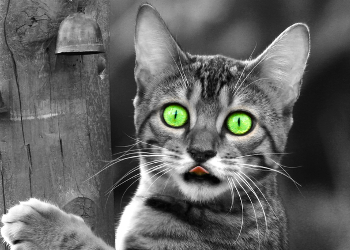


Tapeworms are a common intestinal parasite seen in dogs and cats. Tapeworms are caused by Dipylidium caninum in the dog and cat. Cats can also get infected by another genus of tapeworm known as Taenia sp.
Tapeworms are transmitted to dogs and cats by fleas. The flea initiates an itch and the animal licks at its coat and swallows the flea. The tapeworm larvae, residing in the flea, is now able to develop into an adult worm in the intestinal tract. Cats also develop tapeworms by catching and killing rodents such as squirrels, mice and chipmunks. Once ingested, the larvae turns into a 6 inch long adult worm. It has a head that looks like the head of a Norelco® shaver! These heads attach to the lining of the intestine to get nourishment. The rest of the worm is composed of segments known as proglottids. The farther down the chain, the more mature they become. These are the segments that are commonly seen in the stool or around the perineal region of the animal.
Many owners do not notice any clinical signs in dogs or cats; just the tapeworm segments in the stool or perineal areas. In sufficient numbers there may a mechanical irritation of the worm that causes a mass expulsion of the worms. Animals can have diarrhea and poor coat condition.
Tapeworm segments can be found anywhere in the home. They look like grains of rice and when dried up, have a yellow tint to them. They may be found in animal bedding and areas that the dog or cat enjoys hanging out in. What really infuriates owners is when segments are found on their own bed pillows and linens. They freak out and want immediate treatment. I really can’t blame them!
There are no lab procedures needed to be performed.
Diagnosis is made by finding the tapeworm segments on the animal. If segments are found around the home and there are multiple pets in the household, in time the animal with the tapeworms will be discovered with the typical white segment stuck to its body. Once in a while, a tapeworm egg sack is seen on a fecal flotation.
The treatment of choice for tapeworms is prazaquantel (Droncit®). One dose is usually sufficient but some individuals will repeat the dosage in several weeks to a month.
Treatment will not prevent future infections. You can not stop a cat from hunting. I usually treated outdoor cats every season of the year. This insured that the animal was tapeworm free for the majority of the year.
The prognosis for tapeworms is excellent. There are excellent treatment regimens available. Do not waste your time with over the counter products. They do not work.
The key for dog and cat tapeworm prevention is flea control. Make sure all pets are on a suitable oral or topical flea preparation and the environment is free from fleas by using sprays and or foggers to control flea populations. Clean up all stools found in the yard.
Dog and Cat tapeworms can not be transmitted to humans. Swallowing a tapeworm segment will not produce the infection since an intermediate host is required for transmission: fleas or rodents.



Tear Duct Obstruction is caused by the blockage or outflow of tears from the nasolacrimal duct to the nose or back of the throat.
Tears are produced in special glands in the eye. They serve the function of lubricating the front of the eye and contain products that naturally prevent infections. Tears will also be produced in excess to wash away particles of dust or other irritants that get in the eye. Any condition that causes excess tear accumulation is known as epiphora. It is a clinical sign, not a disease. Epiphora can be seen in tiny, white breeds of dogs like Maltese or Poodles.
In normal animals, tears flow across the cornea and accumulate at the medial canthus; the angle of the eye closest to the nose. They than pass through the nasolacrimal duct and empty into the throat or nose. Obstruction causes a buildup of tears and the associated clinical signs.
Clinical signs associated with tear duct obstruction are: excess accumulation of tears in the eyes, squinting in the affected eye, a rust colored staining of the skin below the lower eyelid and a often a foul odor in the region due to a bacterial or yeast infection in the area.
Lab tests must first be performed to rule out the more common causes of epiphora such as: corneal ulcers, conjunctivitis, foreign bodies, trauma, glaucoma and allergies. Once those causes have been ruled out, an obstruction can be looked into. The easiest way is to use a flourescein strip. It is moistened and applied to the eye. The animal is held still. In a few minutes in most dogs, a green discharge will appear from the nostril which indicates that the nasolacrimal duct is functioning. In obstructed ducts, the green color will not appear.
Diagnosis is made by ruling out other causes of epiphora. A negative response to a fluorescein strip test is suggestive of tear duct obstruction.
The treatment for tear duct obstruction is flushing the affected duct with a nasolacrimal canula. It is an indispensable tool to have around. The duct opening (puncta) is flushed with saline solution and the fluorescein strip is repeated. Some animals may have to have the procedure repeated. In some animals the duct opening never opened fully. Those cases can be surgically corrected by eye specialists.
Infections may be treated with appropriate antibiotic ointments. There are numerous products on the market that claim to remove tear stains from a dogs eye area. Some swear on one or the other. Clients have had off and on success with Angel Eyes®.
The prognosis for nasolacrimal duct obstruction is good; once it is assured that the duct opening remains open, either by frequent flushing or surgery. If a cause can not be found, many dogs need periodic flushing of the ducts to prevent epiphora and the discomforts related to it.



Torn Dewclaws are commonly seen in most medical practices. They are caused most frequently by getting caught in carpets or other braided material that catches the hook of the dewclaw. Animals panic and the tear occurs.
Dewclaws in dogs or cats are akin to the human thumb. As an animal stands, the dewclaw is the digit that is the highest on the inner side of the limb. Dogs and cats are always born with dewclaws on the front limbs. Some will have one or both or none on the hindlimbs.
Dogs normally wear down their nails by walking on hard surfaces such as sidewalks or asphalt streets. The dewclaw never touches the ground so it continues to grow. It will curl around forming a hook or form an ingrown nail. It is this hook that catches the stationary rug. Cats may be polydactyl, a word that means mitten paw or multiple nails on one digit. They can have multiple hooks that can get caught.
Beneath the nail bed tissue resides an artery. When the nail bed is sheared off, the artery is often torn along with it. Arterial blood pulses out. Owners notice bleeding coming from somewhere on the animals paw. Many people can not figure it out because the dog is in pain and the limb can not be examined. Many owners think that the pet has stepped on a sharp object causing a laceration.
No blood work is required unless there has been loss of blood. A CBC is than needed to check the hematocrit.
Diagnosis is by visualizing the torn dewclaw and associated arterial bleeding.
The initial treatment begins at home. Several people will be needed but the goal is to put some type of wrap on the pets lower limb. This may be a gym sock wrapped over the paw, elastic wrap or an old ace bandage. Anything that can apply slight pressure to the wound. Do not apply a tourniquet, unless instructed by your veterinarian. Take the animal to the hospital.
Under a sedative, the artery is closed off, the wound is debribed and the nail is excised. The whole procedure produces a one inch skin line that needs to be sutured and wrapped. Dogs and cats are put on antibiotics and sutures are removed in two weeks. The animal should be confined as much as possible.
The prognosis for dewclaw repair due to arterial laceration is excellent. The key is prevention. Dogs with dewclaws should have those nails clipped short so as to not get caught on rugs and the like. Owners often wish to have them surgically excised to prevent the problem from reoccurring. This is a very common procedure. When taking care of newborn puppies and kittens, I have always recommended that they be removed at 2 days of age. That way, dewclaw problems are never an issue as the animal grows up.
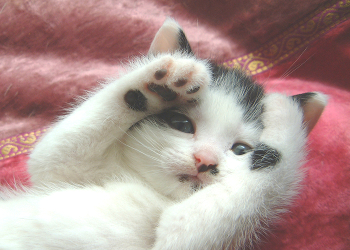


Toxoplasmosis is a world wide disease problem that can cause disease in any mammal. This is caused by the coccidial parasite known as Toxoplasma gondii.
Toxoplasma gondii exists in a cystic form embedded in the musculature of live rodents such as mice or squirrels. Once eaten, the cyst grows to maturity in the cat and the oocysts (eggs) are passed in the cats feces. Without the cat, the life cycle can not finish. If humans come into contact with cat feces containing toxoplasma eggs, they will get toxoplasmosis. The parasite will migrate to the muscle and nervous system. Women with toxoplasmosis will also pass the disease to their unborn children. This usually results in varying degrees of chorioretinopathies.
The dangerous part about the oocyst (egg) is that they are survivors! They can live in the environment for months without desiccating or being destroyed by excess heat or cold. Those eggs have to be in the environment for about 3 days after passing to become infectious to a passing host; be it another rodent or a human.
The USDA (United States Department of Agriculture) has veterinarians that protect our food supply from parasites and diseases such as Toxoplasmosis. In undeveloped countries, Toxoplasmosis may also be transmitted to people by eating contaminated undercooked or raw meat.
In small animals the disease is clinically seen more frequently in cats than dogs. Many cats are asymptomatic and are only involved in the life cycle completion of the parasite. Cats that do get sick have initial signs seen in many diseases: anorexia, lethargy and depression. As the disease progresses signs of jaundice (liver disease), vomiting and diarrhea plus seizures can be seen. Most cats that are healthy often do not show clinical signs. Cats that are immunosuppressed from diseases such as FIV (Feline Immunodeficiency Virus) or FeLV (Feline Leukemia) are at a higher risk of developing signs of the disease.
The most frequently performed tests are immunological or DNA related. Identifying the levels of toxoplasma antigen and the level of antibodies is almost always done. If there is infectious material present, the PCR (Polymerase Chain Reaction) test is very good at identifying the agent. In severe cases, lung fluid can be used to identify the organism.
Diagnosis is made by the presence of the organism by using the PCR test plus the many serological tests that can tell if the infection is acute, chronic or a relapse.
Once in a blue moon, diagnosis can be made by finding the oocyst in the cats feces. This is not reliable since a cat will only pass infected toxoplasmosis oocysts for about 5 days. There are also other common coccidia (Eimeria sp and Isospora sp) that look just like the Toxoplasma gondii oocyst (egg).
The most commonly used prescription drug to treat toxoplasmosis in cats is clindamycin. Other supportive measures such as fluids and other care are provided; particularly if other organs such as the liver, lung and nervous system are affected.
Cats with a straight, uncomplicated case of toxoplasmosis can recover if treated early with clindamycin and other support therapies. Cats that are young or showing multiple organ involvement have a very guarded prognosis. Cats that are immuno-suppressed have a poor prognosis.
As like most things in medicine, prevention is the way to go!
1. If pregnant, do not clean the litter box. Have someone else in the household empty the litter box daily.
2. Do not consume raw meat. Properly wash and clean all foods.
3. Wear gloves when gardening. Cats will defecate anywhere and that includes your garden soil.
4. If you have a sandbox in the back yard for children, make sure it is covered when not in use.
5. Ideally, keep all cats indoors. Without a cat crossing paths with a mouse or other rodent, the life cycle can not complete and hence there wouldn’t be any human disease.
6. Dogs love getting into litter boxes and eating the contents. Elevate litter boxes up on an old table or facsimile to keep dogs from getting to the box.
The fact is, is that cats always get blamed for everything when the word “Toxoplasmosis” come up. In fact, more people get Toxoplasmosis in the United States much more frequently from handling contaminated meat.
Can a cat be checked for Toxoplasmosis? Yes they can be but the results are a twisted irony. If a cat tests positive on antibody titers, it just means that the cat had the infection in the past and has developed antibodies to the disease. This animal is probably immune for life and would not be a concern in any household. The irony is, is that most cats will test negative. That means they have never been exposed to the parasite BUT COULD BE IN THE FUTURE. For that reason, you have to be more concerned about the negative titer cats much more so than cats with an antibody titer.



Transmissible Venereal Tumor is a disease transmitted during copulation. It is seen in both the male and female. The cause of the tumor is unknown.
As with any venereal disease, this tumor can be found on both sexes. It is most commonly seen in young, unaltered dogs. It is not transmissible to humans.
The most common finding is a deep red lobular growth seen on the penis of the male and the vulvar area of the female. They may spontaneously clear but they are quite friable and can bleed a lot if the are picked at or licked at by the animal..
Stain smears of the lesions may be looked at under the microscope but the most important lab test is a biopsy that is sent to the pathologist for diagnosis.
The presence of a lobulated red growth on the genital organs of either sex is enough for a tentative diagnosis of TVD. Histopathology will provide a concrete diagnosis of the condition.
Treatment of TVD is complete excision of the mass; which is than sent for pathology.
If the tumor is benign and it is removed, the prognosis is very good. If the tumor is malignant, the prognosis is much more guarded due to the chance of metastasis to other organs.
Some of these tumors spontaneously disappear. Specific antibodies to the tumor are made inducing it to shrink and disappear. In the mean time owners have to keep the pet from licking at their genitals. An E- collar is very effective to stop that behavior.

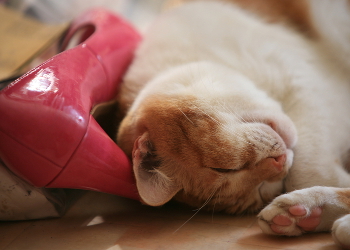

Umbilical hernias are commonly seen in dogs and cats. They also go by the name of omentoceles. An umbilical hernia is caused by a weakening in the rectus muscle near the umbilicus of the dog or cat.
The majority of umbilical hernias are congenital. They are seen in young animals when they are first brought into a medical office for exam. It is noticeable at birth! The majority of umblical hernias contain small amounts of omentum; the protective fat layer that encases the viscera. The majority of these hernias will seal on their own by the time the animal is 6 months.
If left alone, an umbilical hernia has the potential to expand. Intestinal loops can find their way down into the hernia. They usually will twist and strangulate; losing all their blood supply and begin to decompose. In a pregnant animal, a uterine horn may fall into the hernia by gravity. Development of a fetus in such an environment is dangerous.
In a typical congenital umbilical hernia, a small pouch about a quarter of an inch or so will be seen over the umbilicus. In case of a twisted bowel or uterine horn in the hernia; vomiting, anorexia, depression and a warm swelling over the hernia can be felt.
For a congenital hernia, no lab work is required. For complicated hernias, a CBC and Chemistry profile are warranted as well as radiographs that will delineate the contents of the hernia prior to surgery. In case of infections, there will be a left shift neutrophilic leukocytosis.
A diagnosis of an umbilical hernia is made by the visual presentation of a swelling over the umbilicus of the animal.
The majority usually seal on their own before the animal is 6 months of age. Those that don’t are repaired while the animal is being neutered. Sort of like killing two birds with one stone. In the female, it means making the spay incision a bit longer so the hernia can be repaired.
If an intestinal loop is twisted and necrosed, a resection and anastomosis will have to be performed. Depending upon the condition of the uterus, it may be able to be placed back in the abdomen for the rest of the fetal development term. If twisted and decomposing in the hernia, the animal will have to be spayed.
The prognosis for congenital umbilical hernias is excellent. The prognosis for complicated hernias is dependent on the resolution of the intestinal or reproductive issue.
Animals that have umbilical hernias that will be used for breeding purposes should have the umbilical hernia repaired before breeding begins. If owners obtain an adult animal, of either sex, and it has an umbilical hernia, it should be repaired.
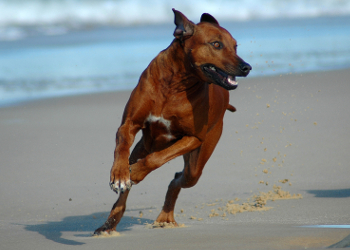


Urethral Obstructions are commonly seen in dogs. The cause of the obstruction is usually caused by calculi (stones), a mucous plug obstructing urine flow or a stenosis (narrowing) of the urethral lumen (cavity) caused by excessive straining.
The urethra is the tube that carries urine from the bladder to the outside while urine is being voided. Any interruption in the flow of urine can result in an obstruction. The bladder continues to fill with urine that can back up into the kidneys. This leads to a post renal uremic condition that is a medical emergency.
The most common calculi that are seen are: struvite (magnesium phosphate), oxalates and urates. Urate stones are seen most commonly in Dalmatian dogs. They are the only dog that produces uric acid in the liver instead of urea as a waste product. Uric acid, like the other crystals, come out of solution secondary to a bacterial infection that causes a rise in the urine pH. These crystals than snowball forming clumps of grit or small stones.
Males will obstruct much more commonly because the diameter of the urethra in males is much smaller than the female dog. Females can obstruct but their urethra is relatively larger than the male. Because of this, they are capable of passing stones that would obstruct a male dog.
Clinical signs associated with urethral obstruction are numerous. It is extremely painful. Dogs will frequently attempt to urinate but no urine comes out even after straining for a period of time. It may appear that the dog is constipated but in reality it is obstructed. It may cry out while urinating or when it is picked up by the owner. Many dogs will lick at their genitals trying to alleviate their problem.
A CBC and Chemistry profile have to be performed to figure out if there is any renal involvement secondary to the obstruction. Radiographs or an ultrasound are taken to visualize the urethral calculi and or any stones present in the bladder. I have seen just one stone plugging the urethra and in other cases stones also present in the bladder. Obtaining a urine sample by a ultrasound guided cystocentesis allows a culture of the urine to be performed and a urinalysis to determine the composition of the calculus and other parameters. It also takes pressure off of the urinary bladder.
Diagnosis is made by a history and physical exam. Radiographs, ultrasounds and abdominal palpation lead the way to making a diagnosis.
The initial treatment goal is to get urine flowing again in a normal fashion plus relieve clinical signs of uremic poisoning due to the obstruction. Emergency cystocentesis is performed; drawing off as much urine as possible from the urinary bladder. This will buy you time trying to get the obstruction corrected. Intravenous fluids are administered to start up diluting built up urea wastes. Cystocentesis may have to be repeated until the obstruction is relieved.
An obstruction can be treated medical or surgically. The toughest urethral obstructions are those at the proximal or top part of the urethra; usually about 4 or so inches south of the bladder. They are very difficult to get to. A urinary catheter is inserted up to the obstruction and flushed under high pressure. The goal is to flush the stone into the bladder where it can be retrieved surgically or dissolved via a stone diet. Bladder stones can also be removed from the urinary bladder as well as the stone flushed back into the bladder from the urethra. There are situations where stones become stuck. Trying to dislodge them from below or from within the urinary bladder are fruitless. It is best that those be handled by a board certified surgeon. The perineal area must be dissected down to the urethra and than removed from there. Quite difficult.
The prognosis for urethral obstruction is usually quite good; as long as the obstruction has been relieved and the owner has been diligent about maintaining an appropriate diet and taking frequent urine samples to the hospital for a repeat urinalysis.



The urethra is the tube that normally transports urine from the bladder to the outside while voiding. The most common causes of urethritis in the dog and cat are: a primary bladder infection, tumors, granulomas (scar tissue), bacterial, trauma, urethral calculi (stones) amongst others.
When the urethra becomes inflamed, the mucosa begins to swell. This swelling causes a decrease in the diameter of the urethra making it much harder for urine to pass through. This leads to the associated clinical signs.
Straining to urinate, urinating more frequently, with or with out blood in the urine, are the most common findings. If there is bleeding it is usually at the beginning of the process. Inflammation is very painful in that part of the body. More straining usually produces a narrower urethral diameter. It is a vicious cycle that could lead to an obstruction if the urethral spasms are not halted.
A urinalysis and urine culture are performed to check for causes of urethritis. The presence of bacteria, crystals, blood and urine pH are important findings. Ultrasounds or radiographs are taken to rule out calculi in the bladder and or urethra.
Diagnosis is made by historical findings, a physical exam and laboratory results.
The most common type of urethritis in dogs is a bacterial urethritis secondary or primary to a bladder infection. In cats the most common type of urethritis is due to struvite stone irritation which is secondary to excess of ash/magnesium in the diet. The former is treated with antibiotics for at least two weeks. The latter by relieving the urethral obstruction. Both species are than put on HIll’s® Prescription Canine or Feline c/d for life.
The other causes of urethritis such as tumors are treated by surgery or radiation. These are uncommon causes in pets. Trauma cases are treated surgically.
The prognosis for most cases of urethritis is good as long as the primary cause is dealt with. The prognosis for tumors and trauma causes are much more guarded.
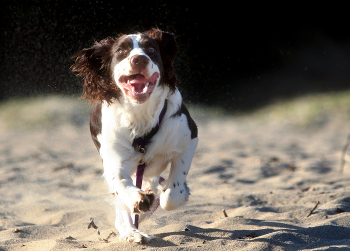


Urinary Incontinence is a problem seen in older male or female dogs due to hormonal changes in the body. Incontinence can also be produced by trauma to the lumbosacral plexus that innervates the bladder. This neurological disorder is also caused by vertebral disk prolapse. It is also produced due to excessive stretching of the bladder resulting from a persistent urethral obstruction.
Animals usually know that they need to go outside to go to the bathroom. It is a voluntary act. There is a sphincter muscle that contracts allowing the animal to hold urine. When it relaxes, urine is able to flow to the outside. Urinary Incontinence is an involuntary act.
In the female, bladder control is due to the formation of estrogen. In the male, it is testosterone. Males can develop incontinence to prostate issues such as benign prostatic hyperplasia as they age. In females, the majority of animals have been spayed in the past. This is a small price to pay for not having unwanted pregnancies or gynecological problems such as pyometra and mammary cancers!
In cases of neurological disruption, the urinary bladder fills but the ability to contract the muscle is not there. Urine than fills the bladder than overflows to the outside.
Urinary Incontinence is an involuntary action. Owners will find pools of urine where the animal sleeps. That could be in its bed or on a favorite sofa. The lower limbs of the animal are usually wet from urine. The skin may become inflamed since urine is a skin irritant. Incontinence is much more common in female dogs than males. The animal may walk and urine dribbles out.
Dogs with spinal disorders may not be able to walk or urinate. Picking the dog up and holding it vertically will cause a stream of urine to exit due to the effects of gravity.
A urinalysis has to be performed. Owners often confuse urinary incontinence with a urinary tract infection. They are easily differentiated by a history, physical exam and urinalysis results. Since the majority of these animals are older pets, a CBC and Chemistry should be performed to evaluate renal and liver function. Some thought to be incontinent dogs were just actually hypothyroid. It had nothing to do with their bladder. They just didn’t have the energy to get up to urinate! Supplementing with T4 took care of that.
Diagnosis is made by historical findings, results of a urinalysis and a physical exam. The big rule out here is a UTI (Urinary Tract Infection).
The majority of dogs treated for urinary incontinence are older, spayed females. They are also usually overweight. Hormone replacement therapy is the usual way to go. Phenylpropanolamine is the drug that is usually prescribed. In humans (before it was taken off the market for people) it was a nasal decongestant. Given twice a day, the drug is very effective at stopping incontinence in female dogs. Veterinarians used to use the human drug. When it was withdrawn for human use, veterinarians across the country had heart failure; as there was nothing else to treat the problem with. Thank goodness, a veterinary version was produced named Proin®. It must be taken daily for it to be effective.
The only reason that phenylpropanolamine is being used is that the best treatment was pulled by the FDA. It was diethylstilbestrol or DES. A 1mg DES tablet once or twice a week, bingo! Some compounding labs are still able to manufacture it for off label use.
The prognosis for the common incontinence seen in older spayed females is excellent, as long as therapy is maintained. The prognosis for spinal disorders is much more guarded over time.

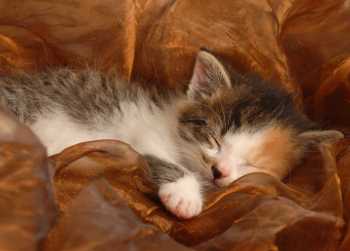

Eclampsia is a post partum condition seen in lactating females that have delivered an unusually large litter. The cause of eclampsia is do to calcium depletion resulting in low serum levels of the mineral. The bottom line is that the parathyroid glands (responsible for calcium levels) can not keep up with demand.
Calcium is one of the most important elements in our bodies. It is needed to manufacture bone and is essential for milk production. Toy breeds such as Yorkshire Terriers, Maltese and Chihuahuas do not have the reserves to handle calcium demands for a large litter of puppies.
During normal times, a dogs dietary calcium needs are met from dietary needs. When a toy breed becomes pregnant and fetal skeletons start to develop, a strain is put on maternal calcium levels. When she starts to lactate (produce milk) that additional strain on calcium stores bring her close to “the edge”. Her body can not keep up with calcium demands.
Eclampsia can occur anytime before the puppies are whelped up to about a month after delivery. The pups are not effected since their needs are being taken care of by the mother.
A drop in serum calcium is the result which leads to all associated clinical signs in the female animal.
The most common sign of low serum calcium levels is a tetany or severe contraction of skeletal muscle. Vomiting, diarrhea, ataxia or disorientation is seen. Animals will eventually become recumbent and spasm. Because of the constant muscle spasms, the dog will become hyperthermic with an elevated rectal temperature. If not treated, coma and death will occur.
A CBC and Chemistry profile are crucial. A profile will show a low serum calcium level of about 7.5 or even lower. Some animals will also be hypoglycemic at the same time. This is always a big problem in tiny dogs; particularly recently born toy breeds or their crosses.
The most important diagnostic aid, outside of blood calcium levels, is the history obtained from the owner. How many puppies were delivered, when were they delivered are just a few of the questions that your veterinarian will ask you.
Treatment is geared towards correcting serum calcium levels and the hyperthermia. An intravenous catheter is placed with fluids for circulatory support. An intravenous bolus of Calcium gluconate is given which immediately stops all signs. This may have to be administered until serum calcium levels return to about 10. Dogs that are hyperthermic will have to be cooled with a cool water bath to reduce body temperature.
Initially, puppies should not be allowed to nurse since they will take essential calcium from the mother’s body. They will need to be bottle fed until maternal calcium levels return to normal level or just bottle fed until they are weaned at 5-6 weeks of age.
The prognosis for rapidly diagnosed and treated dogs is excellent. It is simply amazing to see them recover; acting as if nothing was wrong in the first place!
Prevention is not guaranteed but it is a good place to start. Once a toy breed becomes pregnant, it is a good idea to put her on an appropriate calcium supplement. Too much calcium can produce painful deposits in the joints. A product that I have used over the years is PET-TABS® CF. It is a daily dietary supplement that is also matched to the appropriate amount of phosphorous.
Recently pregnant animals should be placed on a high quality puppy diet while they are pregnant. The extra calories and nutrients in puppy food will indirectly aid in fetal skeletal development and lactation.
When the female is about a couple of weeks away from delivery, the veterinarian can draw blood to check the animal’s calcium level before she delivers.



Warbles are extremely common in the cat population. The insect causing warbles belongs to the genus, Cuterebra sp, a fly that normally infests rodents such as squirrels and rabbits. Its larvae cause the problems in cats.
Cuterebra sp usually lays its eggs on long grasses. The eggs hatch and cling to the blades of grass. When a rodent or a cat passes by, the larvae jumps over to the new host and enters an orifice. The ears, nostrils, anus and genital organs are the most common port of entry. The parasite than migrates through the body and usually makes a bee line to the skin. This passage and skin lesions cause the clinical signs associated with warbles.
The parasite is very common up north. I would usually see Cuterebra sp cases beginning around August and lasting up to cool fall weather. Late summer is a very active time period for the insect to reproduce. In wild animals the mature larvae will fall out of the skin hole. It gets its nourishment from cat serum and tissue fluids. Once on the ground, it will pupate.
During the larval passage in the cat, it may traverse the lungs and neurological system resulting in signs such as difficulty breathing as well as ataxia and disorientation. Most cats present with the skin lesion containing a “breathing hole” with the parasite just underneath the skin surface. I have also plucked them from both nostrils and genital tissues.
Any cat presenting with neurological or respiratory signs require a complete workup such as radiographs and blood chemistries. In the more common presentation, most cats do not need any lab work unless the warble area is infected. In that case running a CBC is advisable.
Diagnosis is most commonly made by finding a breathing hole on a cats body in late summer or early fall. Most skin lesions are located over the shoulder blade areas or neck of the cat. Many individuals bring the cat into a hospital thinking that they are dealing with an abscess. If you look at the lesion long enough, you will see the white larvae pop itself up in the hole in the skin.
If the larvae is still present in the hole, it is removed. Some cats require sedation. The goal is to remove the larvae intact. Rupturing the contents into the wound can cause a severe allergic reaction so care must be taken. If needed, I would slightly enlarge the breathing hole so I could remove the parasite with forcepts. The wound is cleaned and debribed. The animal is than put on a broad spectrum antibiotic. Like abscesses, warble damage will heal from the inside out leaving just a small scab.
Cats are accidental hosts of Cuterebra sp. If there are no systemic issues to deal with, the prognosis is excellent. Keeping cats indoors will prevent this problem.



Vaginitis is inflammation of the vagina and the vaginal vestibular area; the cavity from the vaginal opening to the cervix. The most common causes of a vaginal infection are: bacteria, yeast, maggots or other insects, foreign bodies, trauma, urinary tract infection and puppy vaginitis. The latter is seen in immature females that present with pustules around the vulvar area. These usually disappear as estrogen levels increase as the animal sexually matures.
Regardless of the cause, any vaginal irritant will cause an inflammatory response in the vaginal mucosa. This irritation will lead to all clinical signs associated with vaginitis.
Vaginitis bothers the dog. Animals will often have a mucoid or purulent (pus containing) discharge coming out of the vulvar area. It usually has a foul odor. Yeast infections will produce a foul, sweet smell. Dogs will lick at their vulvar and perineal areas. Urine is an irritant and in the female passes right over inflamed vaginal mucosa. This causes a burning sensation and the dog will often urinate inside the home or if outside, more frequently (pollakiuria). The vulvar area may appear enlarged or inflamed.
Vaginal smears and cultures are the hallmark tests of vaginitis. The smear is than stained and looked under high microscopic objective power. Bacteria, yeast cells and white cells can easily be noticed. Cultures will demonstrate bacteria or yeast and sensitivity will provide the most effective treatment option.
In animals with a suspect vaginal mass, ultrasounds are very handy to delineate those growths.
Diagnosis is made by historical, physical exam and laboratory findings. A vaginal exam is performed with a gloved finger and or a special scope that allows the vestibule to be viewed. This is much easier on a large dog!
Treatment of vaginitis usually responds to antibiotic therapy. The drug used depends upon the results of sensitivity tests to the offending pathogen. Douches containing chlorhexidine are also prescribed. The vulvar area should be cleaned several times a day with warm, soapy water. Treatment of the primary cause should also be undertaken. Urinary tract infections, trauma and growths require their own treatment plan.
The prognosis for straight bacterial or yeast vaginitis infections is very good. Prognosis of those caused by urinary tract infections is also good but it may relapse along with the UTI. Prognosis for the removal of tumors or growths depends upon the histopathological diagnosis of the mass.
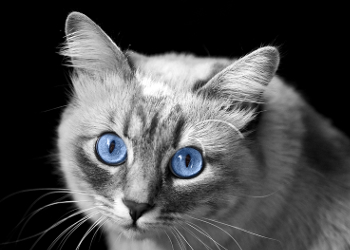


Vomiting is defined as the active expulsion of stomach contents to the outside. Vomiting can be caused by a myriad of diseases or agents. Some of them are: viral (Parvovirus), bacterial, poisons, spoiled food, parasitic, stomach cancers, food allergies, foreign bodies swallowed, drugs (Clavamox®) and gastric ulcers. Causes of vomiting secondary to other medical problems are: liver disease, pyometra, vestibular disease, pancreatitis, Irritable Bowel Disease/Complex, Cat or Dog Distemper and Canine GDV (bloat).
Vomiting by itself, is not harmful. It is a mechanism to rid the body of any foreign or dangerous substance. Getting something out of the body before it can cause damage is one of the great functions of the mammalian body. Vomiting entails communicating with the brain. There are vomiting receptor sites in the brain that stimulate nausea and vomiting. This entire procedure requires the contraction of abdominal muscles and the diaphragm to expel food to the outside. It must be differentiated from regurgitation. Regurgitation is the couging up of food that is in the esophagus. It has not entered the stomach. Food that is regurgitated is not digested and looks like it was just swallowed. An example is a cat that regurgitates its meal after eating due to stomach hairballs.
The digestive tract is one long tube that extends from the mouth down to the anus. If one part of it becomes irritated there is a good chance the other part will also. Many dogs that vomit over time will usually start producing a watery diarrhea. This is because the stomach is “hooked” up to the duodenum, the first part of the small intestine.
Vomiting has a safety feature but if it continues unabated, can lead to stomach ruptures, electrolyte imbalances and dehydration. This is what leads to severe medical problems in dogs or cats.
Dogs and cats get into a particular positioning when they are ready to vomit. They often get hunched up and the signs of nausea begin. Excessive drooling is than followed by intense abdominal musculature contractions followed by the expulsion of gastric contents. This expulsion does not occur in dogs with GDV (bloat). The vomit is usually a green, yellow bile color and the ingesta is mixed with stomach mucous.
I was a small animal veterinarian for 33 years and never worked on horses throughout my career. One thing I do remember, is that horses naturally will not vomit. If they do, it means a ruptured stomach!
A CBC and Chemistry profile are always done. Electrolyte imbalances, organ dysfunction and other data can point to the clinical degree of vomiting and a possible systemic cause such as renal failure. Radiographs and ultrasounds are handy to visualize the stomach contents for foreign bodies and masses.
Vomiting must be differentiated from regurgitation when an animal is presented. The history from the client is crucial. Taking a video with a camera phone is very helpful so the veterinarian can actually see what the dog or cat is doing. Once vomiting has been found to be the case, figuring out what is causing it starts the detective case. The history of garbage ingestion or a foreign body or other tidbits is very important. Vomiting in cats can be very difficult to figure out. After years working on cats, my only explanation for that is that well…it is a CAT! Cats always throw curve balls at practitioners!
Diagnosing vomiting is part of the problem. A diagnosis of what is causes it is made by interpreting physical exams, radiographic or ultrasound data and blood chemistries combined with owner history.
Treating vomiting animals is important but the cause of the vomiting must be found and managed. Each systemic disease is different and requires different treatment plans. Foreign bodies need to be removed with an endoscope. Treatment is based on the cause of vomiting.
Sometimes, the cause can not be found. Animals will often just throw up for no reason! Animals should be examined regardless of how many times the animal has vomited. Treatment of vomiting is based around resting the stomach. This allows the stomach muscle to rest and heal. In the hospital, dogs are frequently given injections to stop vomiting. They include: famotidine, Cerenia®, or ondansetron. Famotidine and Cerenia® are also available for oral administration.
Animals that have a systemic disease or are extremely dehydrated will be hospitalized and given fluids via a intravenous route. This hydration is important plus helps to maintain blood flow to the kidneys as well as replenish lost electrolytes. Once animals have been treated with fluids and anti-vomiting drugs the stomach is allowed to rest. Small amounts of fluid are than allowed. If they stay done a bland diet of chicken and rice can be offered in SMALL doses!! Animals are than discharged on the appropriate therapy needed to treat the primary cause as well as anti-vomiting drugs plus an appropriate diet. Owners can feed small amounts of chicken (or beef) and rice in a ratio of 1 part meat to 3 parts boiled rice. If you use hamburger, boil it so as to remove all the grease. If you do not want to cook, purchase Hill’s® Prescription Canine i/d or Hill’s® Prescription Feline i/d from your veterinarian. If your dog or cat has an off and on problem with vomiting, it may be food induced. Maintaining pets on these prescription diets often stops regular vomiting altogether.
The type of fluids administered to the pet at home is crucial. Do not give pets cow’s milk. It will make them vomit and have diarrhea. Dogs can not digest milk sugar since they do not have enough lactase enzyme to do the job. Plain water can be difficult to stay down on an upset stomach. Try offering small amounts of a sport drink such as Gatorade®. If the animal does not drink it straight, try diluting it in a bit of room temperature water. Dogs love ice cubes. Freeze some sports drink and throw just a few ice cubes of it into the dog’s water bowl. Sports drinks will help to replenish electrolytes lost during vomiting plus will make the dog or cat feel much better at the gut level.
Prognosis for vomiting runs the gamut from basic to complex. The prognosis for dogs or cats with minor causes of vomiting is excellent whereas the prognosis for a chronic vomiting dog with end stage renal failure is poor. Prognosis depends upon the cause and severity of the primary problem.
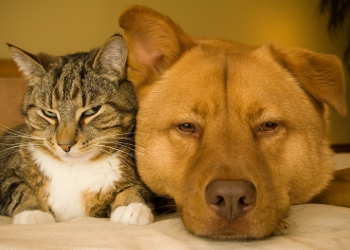


VonWillebrands Disease is a clotting disorder seen in dogs. It is due to the lack of the VonWillebrand factor necessary for clotting to occur. It is a protein and facilitates the clotting process. It also leads to a defect in the VIII (8th) clotting factor.
In normal dogs, all the clotting factors and platelets come together to form clots after vascular injuries or trauma to the skin or vessel. Without the clotting mechanism, animals can bleed to death even after a small laceration. Clotting will not occur in Von Willebrand deficient dogs. It is akin to human hemophilia.
Von Willebrand’s disease is inherited and is the most commonly seen inherited blood disorders in dogs. It is commonly seen in Doberman Pinschers, Golden Retrievers, Miniature Schnauzers amongst others.
The most common signs seen are a prolonged bleeding and clotting time. Even the simplest things that normally clot will take a long, long time to clot. Examples are: nail trim bed bleeding that occurs when a nail is cut too short, a female in estrous will bleed excessively. A small scrape can turn into a huge ecchymotic (subcutaneous hemorrhage) wound area. This is very risky if surgery is being performed, as blood vessels are extremely difficult to ligate to seal off blood flow.
When presented with any blood disorder, a CBC and Chemistry profile must be done to check out platelet levels and red cell counts. Specific tests are the ELISA test that tests for the presence of the Von Willebrand clotting factor. A buccal mucosal test may also be performed. In this test, a small, oral injury is created and the time it takes to clot is measured. Using this value and the platelet level are very helpful.
A lot of animals are diagnosed after an “incident” has occured. That may be due to trauma, difficulty ligating vessels in surgery or any other common day to day procedure. HIstorical findings combined with all the lab work, including specific tests, lead to a diagnosis of the disease. Doberman Pinscher dogs are perhaps numero uno in getting this so just the presence of a Dobey makes you wonder.
Treatment of Von Willebrand’s disease is by transfusing the animal with whole blood that contains the essential clotting factor. The disease can not be cured. Some animals may require multiple transfusions. Desmopressin (DDAVP) has been used to stimulate clotting factors prior to surgery in an affected dog. Blood is sometimes treated with this drug. Desmopressin is a synthetic version of the body’s own vasopressin (ADH). It is produced in the posterior pituitary and is involved in maintaining sodium levels. For this reason, DDAVP should not be routinely used for periods of time as it will lead to hyponatremia (low blood sodium) and seizures.
Even though the disease can not be cured, animals with Von Willebrand’s disease can lead normal lives. Owners have to do their best to keep their pets away from cars and other trauma inducing events. That means using a leash when walking the dog. Care must be taken and advance preparation necessary for any surgical procedure performed on any of these dogs.
Individuals that are breeding the commonly affected dogs might want to see which of their breeding stock is affected by the inherited disorder. One would not want to breed an animal that carries the defect.
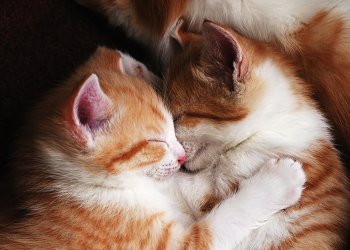


Whipworms are small intestinal parasites that cause diarrhea in the dog. The parasite is caused by Trichuris vulpis.
Whipworms are passed from animal to animal by fecal contamination. The egg dissolves leaving a larvae to devolop in the cecum. The cecum is that part of the intestinal tract that separates the small intestine from the colon. Here, they suck blood and cause mucosal injury. This injury leads to typical clinical signs.
Whipworms cause a watery, bloody diarrhea in dogs. In untreated animals, the diarrhea may be off and on depending on the level of intestinal parasites. Lack of condition and weight loss may also be seen in infected dogs.
A fecal flotation will show the characteristic whipworm egg. It looks like a wine barrel with 2 plugs at each end. It looks very similar to Capillaria plica; a parasite that plays havoc in the urinary tract system. The problem is, is that whipworms are not generous egg producers when compared to other intestinal parasites. They do not always produce eggs so a negative fecal may not mean that they are not there.
Diagnosis of whipworms is made by finding the characteristic egg in a fecal flotation test. Many times it is impossible to find the egg so any dog presented with a off and on or chronic diarrhea is always treated for the parasite.
Treatment is effective but the eggs are very difficult to get rid of in the environment so it is important to clean up the animals bowel movements. Multiple treatments may be necessary to eradicate the parasite. The most commonly used preparations are:
1. Drontal Plus® (febantel)
2. Panacur® (fenbendazole)
Monthly heartworm products such as the following are quite useful in treating whipworm infections:
1. Interceptor® (milbemycin oxime)
2. Advantage® Multi (moxidectin)
3. Trifexis® (milbemycin oxime)
Once the animal is treated for whipworms, or any dog that has chronic diarrhea associated with whipworms, a good prognosis is warranted. Once the dog is treated though, does not mean it will not pick up the parasite again. Getting rid of dog feces in the yard and treatment of other pets in the household will aid in eliminating the parasite. Dogs should not be allowed to run free or even sniff other dogs bowel movements while out on a walk. The eggs get on the nose of the dog, the tongue goes in and out, and an infection will commence!

